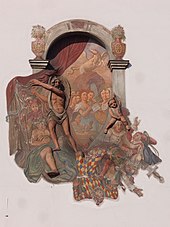Hanswurst
The Hanswurst (also Hans Wurst ) is a crude comic figure of the German-language impromptu comedy since the 16th century ( Hans worst ). As popular peasant figure of the clown came in pieces of carnival theater and traveling theaters on. “Hanswurst” was (and still is) used as a mockery and swear word . Antics or plays with the Hanswurst in the main role are also called Hanswurstiade .
The versions Wurschtl, Hansnarr, Hansdampf, Kasperl and Bajazzel were created in Austria .
External description
According to his most famous actor, Joseph Anton Stranitzky , the buffoon looked like this: His costume consisted of a red, open jacket with puffy sleeves, a blue patch on the chest and a green heart in the middle between the red, green braces. He wore wide yellow trousers that only came down to his ankles, low, tough leather shoes and a wide leather belt with a large metal clasp, a green pointed hat on his head and a wooden sword on his belt.
history


The name appears for the first time in a Middle Low German version of Sebastian Brant's Narrenschiff (1519) (the name hans myst was used in the original version ). Martin Luther used it in 1530 in a warning to the clergy, gathered at the Reichstag in Augsburg , and wrote the pamphlet Against Hans Worst in 1541 . In the 16th and 17th centuries this figure name is occasionally found in carnival games and comedies . In 1775, the 26-year-old Johann Wolfgang Goethe wrote a farce entitled Hanswurst's Wedding .
The traveling doctor and tenant of the Kärntnertortheater in Vienna since 1712, Joseph Anton Stranitzky, competed with the Commedia dell'arte troops with his troupe "Teutscher Komödianten" and developed the Hanswurst as a "German" comic figure. The theater historian Otto Rommel saw in this the beginning of the so-called old Viennese folk theater . Stranitzky's Hanswurst wore the costume of a Salzburg farmer ( Lungauer Sauschneider ), had a wide-brimmed hat and a fool's cot . Stranitzky wrote parodic " main and state actions " in which the buffoon mostly drove his stage mischief as a servant figure. This buffoon found numerous imitators. Stranitzky's son-in-law, Gottfried Prehauser (1699–1769), came as his successor from Salzburg to Vienna in 1725, where he replaced Stranitzky at the Kärntnertortheater as the “New Viennese Hanswurst”.
In the " Hanswurst dispute " since the 1730s, the scholar Johann Christoph Gottsched , together with the actress Friederike Caroline Neuber , tried to ban the Hanswurst from the German-speaking stage in order to improve the quality of German comedies and above all to raise their social status . This met with resistance, especially in Vienna. Also, as a principal of an acting company , Caroline Neuber could not do without the Hanswurst completely for economic reasons. The fighters against Hanswurst, like Johann Friedrich Schönemann in Germany, were nevertheless a kind of trailblazer for the educated German city theater .
The last significant Hanswurst was Franz Schuch , who died in 1763 , who brought the Hanswurst back closer to the Italian-French harlequin . In the later 18th century the Hanswurst went out of fashion and was only used in puppet theater . Funny characters like Kasperl or Staberl replaced him for a few decades. At the instigation of Joseph von Sonnenfels after the French Revolution ( memorandum for the policies of the future theater censorship , 1790) forbade Emperor Joseph II. In a hand ticket the impromptu comedy and burlesque-like buffoon games and led the theater censorship one. Because of the authorities' fear of political agitation , the impromptu comedy turned into a literarily fixed theater (the "regular stage") or into the silent, music-accompanied pantomime . In his comedy Puss in Boots , written in 1797, Ludwig Tieck lets Hanswurst perform again. On the occasion of the Vienna Music and Theater Exhibition in 1892 , the Hanswurst was reborn again by the actor Ludwig Gottsleben .
In the German film Komödianten (1941) by GW Pabst , which was shaped by the ideology of the war era, Gotthold Ephraim Lessing competes as the German national poet in the victorious fight against the foul buffoon. - In the Hamburg Dramaturgy, however, the historical Lessing spoke out in favor of the Hanswurst.
See also
- Arlecchino
- Bajazzo
- clown
- Jack of all trades
- Leporello, figure from Don Giovanni
- Funny person
- Petrushka
- Pickled herring
- Pierrot
- Punch
- Thaddädl
literature
- Eike Pies: I'm Doctor Eisenbarth. Road Doctor. A picture biography . Ariston, Geneva 1977, ISBN 3-7205-1155-3 .
- Helmut G. Asper: Hanswurst: Studies to make fun on the professional stage in Germany in the 17th and 18th centuries . Emsdetten: Lechte, 1980.
- Hugo Aust, Peter Haida, Jürgen Hein: Volksstück. From Hanswurstspiel to contemporary social drama, Munich: Beck 1996. ISBN 3-406-33606-X .
- Beatrix Müller-Kampel: Hanswurst, Bernadon, Kasperl: fun theater in the 18th century . Paderborn [u. a.]: Schöningh, 2003, ISBN 3-506-75812-8 .
- Otto G. Schindler: Hanswurst. In: Oesterreichisches Musiklexikon . Online edition, Vienna 2002 ff., ISBN 3-7001-3077-5 ; Print edition: Volume 2, Verlag der Österreichischen Akademie der Wissenschaften, Vienna 2003, ISBN 3-7001-3044-9 .
Web links
- Entry on Hanswurst in the Austria Forum (in the AEIOU Austria Lexicon )
- Wurstel's subversive slapstick research magazine UNIZEIT of the University of Graz
- Mr. Kant looks strictly at Austria or: How the anarchist Hanswurst became a dear puppet. from the magazine title. literature and more .
Individual evidence
- ^ A b Friedrich Kluge : Etymological Dictionary of the German Language , Walter de Gruyter Verlag, 19th edition. Berlin 1963, p. 288
- ↑ Hanswurstiade in the Duden

